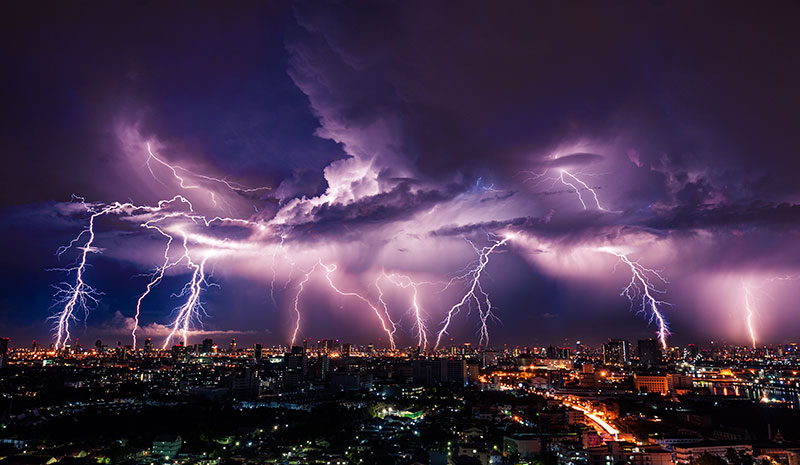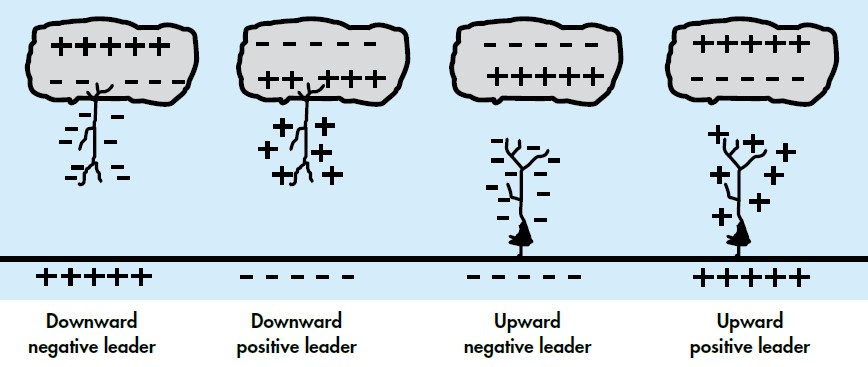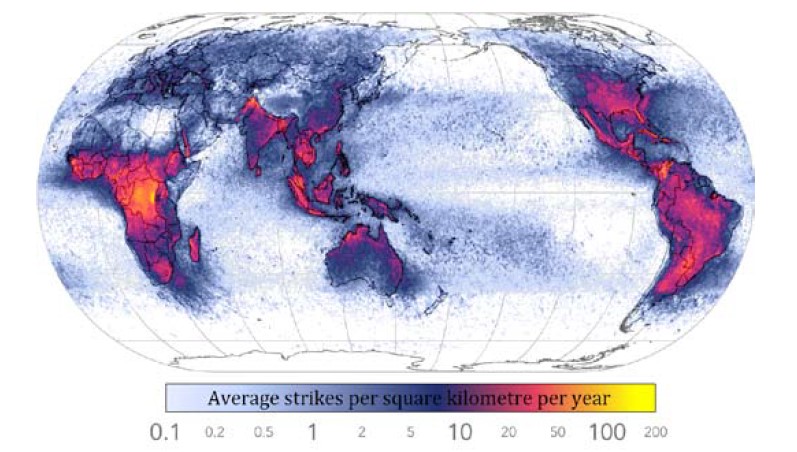General information about lightning – created by France Paratonnerres
The lightning phenomenon
Lightning is a natural phenomenon of disruptive electrostatic discharge which is produced when static electricity accumulates between a cloud and the earth. The different electric potential between the two points ,can be up to 100 million volts and produces plasma on discharge, causing an explosive expansion in the air through release of heat. When itdisperses, this plasma creates both a flash of light (lightning) and a sound (thunder).

Formation of or the arrival of a storm cloud creates an electric field between the cloud and the ground. This electric field increases up to values of 10 kV/m, thus initiating creation of corona discharges from irregularities on the ground or from metal structures (projections). Lightning between the cloud and the ground is composed of both downward leaders and upward leaders.

The negative downward leader (most frequent case), starts within the negative masses of the cloud. This leader then propagates downward in a succession of intermittent steps (contrary to the positive leader which travels without stepping) of about ten metres and with pauses of 40 à 100 μs between steps. As the leader progresses, one can see numerous forks pointing downwards.
When the electrostatic field is over the dielectric limits of the air (variable depending on humidity and atmospheric pressure), a lightning discharge is produced and accompanied by a sound wave: thunder (produced by the sudden dilatation of air over heated by the electric arc).
The manufacture of lightning risk protection implicates assessing geographic and climatic conditions to determine the level of exposure to the structure which is to be protected.
The parameters to consider are notably:
- The Keraunic level Nk : It expresses the mean annual value of the numbers of days with storms (days when thunder can be heard in a specific place).
- Density of strike Ng : It indicates the mean value of the number of lightning strikes noted per year and per km2

Without adequate protection, propagation of lightning current can lead to multiple effects which are divided into two main categories: direct and indirect effects:
Direct effects
- Mechanical Effects take place when lightning strikes (such as distortion, break-off destruction, …)
- Thermal Effets (or «Joule’s law») cause fusion on impact point, or destruction by explosion of the material or even starting of fires.
- Electrochemical Effects mean the chemical transformation of materials through electrolytic reactions (negligible, mostly present on earths).
- Step potential can provoke burns or cause respiratory failure or cardiac arrest when the lightning current passes through heterogeneous soils.
Indirect effects
- Overvoltages are conducted when lightning strikes an electrical line or pylon directly. The current is propagated and reaches all the installations along the line, even several kilometres away from the point of impact.
- Overvoltages are induced by electromagnetic radiation of the lightning current on all nearby metal elements. Overvoltages and transient currents thus appear on all equipment which is connected to these elements, with proportional effects depending on the intensity and proximity of the lightning strike.
- Surges in tension on the earthing systems, which take place when the current spreads into the ground, provoke damaging tension differences between the mass of the equipment and the networks to which they are connected.
- Earth potential rise of non-negligible current from a lightning strike is evacuated by the earth of the air terminal and sent to the earth of the installation.
To reduce and to protect from these different effects (both direct and indirect), it is necessary to have a stateof- the-art Installation for External Lightning Protection System (ELPS) and Interior Lightning Protection System (ILPS), with particular care taken in earthing and interconnections with the conducting elements running alongside the down conductors poles and the electric masses of the installation.
